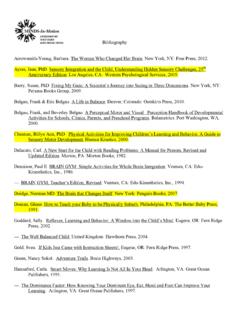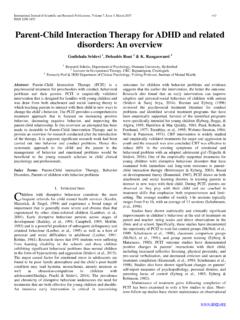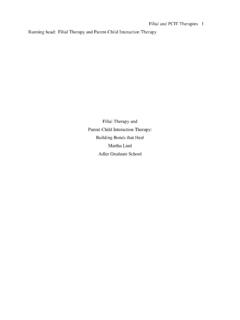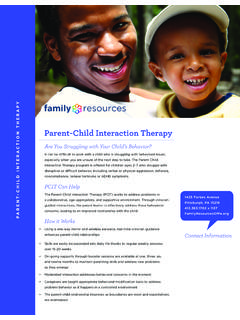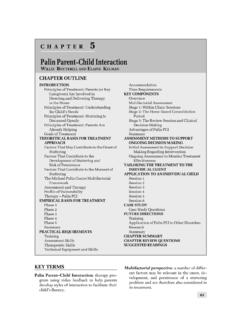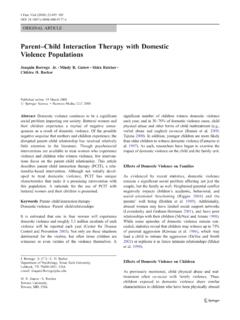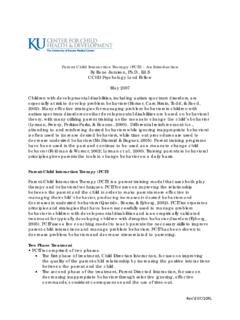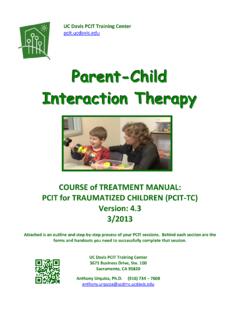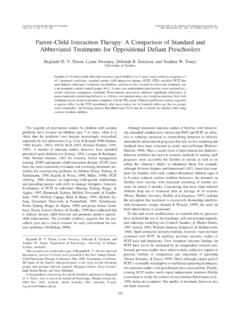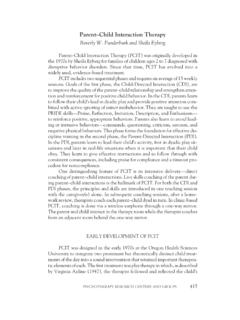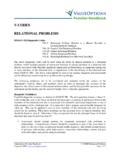Transcription of Parent-Child Interaction Therapy - WV Early Childhood
1 An Introduction to Parent-Child Interaction TherapyJocelyn Stokes, PhD, BCBAM arshall University School of Medicine Department of Psychiatry and Behavioral knowledge of Parent-Child Interaction when and how to refer for Parent-Child Interaction TherapyThe Problems Disobeying directions Rule breaking Property destruction Aggression Tantrums/ Meltdowns/ Fits/ Outbursts Interrupting Diagnoses: Oppositional Defiant Disorder, ADHD, Other Conduct DisorderVideo 1 &2: Seeking Help How I decided my child needed help part 1 How I decided my child needed help part 2 Back in of PCITC onstance Hanf: The HanfModel of Behavioral Parent TrainingReitman & McMahon, 2013 Baumrind sResearch on Parenting HanfTwo-Stage Model child s Game First phase: Increase positive Parent-Child Interaction Playing with the child Selective Attention to Appropriate Behavior Praise Ignoring Parent s Game Second phase: Reduce problem behavior Effective Commands Consequences for Noncompliance and Rule-Breaking Time Out Tangible Rewards (Provision and Restriction)Origin in Applied Behavior Analysis (Cooper, Heron, & Heward, 2007)Constance Hanf.
2 The HanfModel of Behavioral Parent TrainingReitman & McMahon, 2013 Defiant child (Barkley)The Incredible Years (Webster-Stratton)Helping The Noncompliant child (Forehand/ McMahon) Parent-Child Interaction Therapy (Eyberg)Back to the Interaction TherapyMy Background Constance HanfSheila EybergCheryl B McNeilJocelyn Stokes Post baccalaureate work with the Incredible Years PCIT in graduate school West Virginia University PCIT during post doctoral fellowship Jason Jent, PhD University of Miami Miller School of Medicine Provided PCIT for 50+ parents & children Co-facilitated 3 PCIT trainings for therapists Trained 5 therapists to competency using a mentor model What is Parent-Child Interaction Therapy ? An evidence-based treatment for young children with disruptive behavior Treatment length typically 12-20 weekly sessionsFirst Phase: child -Directed InteractionPRIDE Skills Labeled Praise Reflections Imitation Behavior Descriptions EnjoymentAvoid Skills Commands Questions Negative TalkIgnoring of Minor MisbehaviorSecond Phase: Parent-Directed Interaction Effective Commands Labeled Praise for Compliance Time out House Rules Public BehaviorWhat makes it PCIT?
3 The manual Mastery criteria Coaching sessionsThe Evidence Base for PCIT Children 3-6 years old (Children 2-7 years old) Disruptive behavior Maintenance of change for at least 2 years Reducing recidivism in parents who have been physically abusive Children 2-12 yearsAutism Spectrum Disorder and Developmental DisabilitiesSeparation Anxiety (with extra component)Diverse Cultures: African American Hispanic/ Latino American Indian Asia Maori in New Zealand Northern Europe AustraliaChildren 7-9 years old To Refer a Family to Certified PCIT al., 2012; Agazziet al., 2013; Bagner& Eyberg, 2007; Bigfoot & Funderburk, 2011; Borrego et al., 1999; Brestan, et al., 1997; Capageet al., 2001; Chaffin et al., 2004; Chaffin et al., 2009; Chaffin et al., 2010; Choate et al., 2005; Eisenstadt, et al., 1993; Eyberg, 1988; Eyberg& Funderburk, 2011; Hakmanet al.
4 , 2009; Herschell, et al., 2002; Lesacket al., 2014; Leung et al., 2009; Matos et al., 2009; McCabe & Yeh, 2009; McNeil, et al., 1991; McNeil & Hembree-Kigin, 2010; Nixon, et al., 2003; Phillips et al., Puliaficoet al., 2012; Schumann, et al., 1998; Solomon et al., 2008; Timmeret al., 2005



